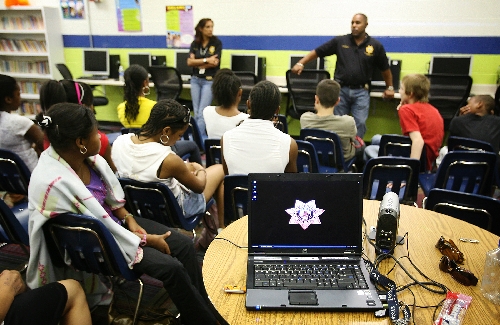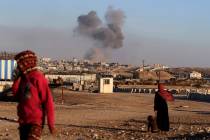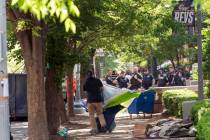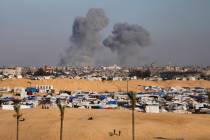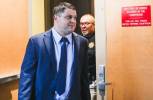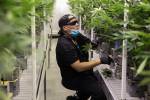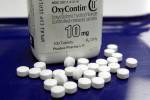CDC studies drug and alcohol abuse, sexual activity among teens
A grainy video of the 1999 Columbine massacre plays on a laptop projector in the library at the Andre Agassi Boys and Girls Club.
"You want me to stop right now?" shouts the armed teenager in the video.
Students cower behind chairs and under tables. A girl starts to cry. Then come the shots.
About 30 kids -- some from Las Vegas' roughest neighborhoods, from broken homes, from foster care -- watch the screen intensely. When the video is over, one teenager at the Agassi clubhouse sits and stares in disbelief.
"I don't want to see any dead people," he says. "I've seen so many dead people already."
Las Vegas police use the Columbine video to teach teens about risky behavior.
The Centers for Disease Control has tracked risky behavior in teens nationwide over the past 20 years. The CDC surveys kids about choices that put them at risk of ill health, addiction or death. The questions cover a range of topics -- from eating habits and physical exercise to sexual activity and tobacco, alcohol and drug use.
The most recent Youth Risk Behavior Surveillance report, released last month, includes national, state and local surveys of students polled from September 2008 to December 2009. The national sample was a weighted survey of more than 16,000 students.
"Since 1991, the prevalence of many high-risk behaviors among high school students has decreased," the report concludes. "However, many high school students continue to engage in behaviors that place them at risk."
The nationwide survey includes such statistics as 17.5 percent of the students had carried a weapon, 7.4 percent had been forced to have sex and 6.3 percent attempted suicide.
The report also includes state surveys of more than 120,000 students from 42 states, including 2,085 students in Nevada. Twenty metropolitan areas also were surveyed, including 1,461 students in Clark County.
Nevada ranks near the middle of the states on most questions. The CDC's appraisal of Nevada youth seems at odds with a place that has the nation's worst jobless, foreclosure and high school graduation rates.
But the survey also shows prescription drug abuse, methamphetamine use and binge drinking are on the rise in Clark County .
Health educators said the numbers are encouraging, however, because a poor economy often is a precursor to teens becoming involved in dangerous activities. They said attentive parents, clear communication among relatives and getting teens involved in positive activities are factors that help prevent them from becoming involved in risky behavior.
Here are some of the survey's findings:
drugs
Teens statewide are using prescription drugs, methamphetamine, cocaine and marijuana at a higher rate than on a national level. That raises concerns among law enforcement agencies and health educators.
Police have noticed an increase over the past two years in prescription drug abuse among high school kids who host pill parties, an activity also known as "pharming."
At the parties, kids steal over-the-counter and prescription drugs from medicine cabinets at their homes, dump them into a large bowl and fish around for different pills to get high, said Sgt. Mark Sharp, who heads Metro's youth education services.
His division has 18 officers who teach students about making good choices and avoiding such risky behavior as drug and alcohol abuse, gang violence and using weapons.
"It's easier to get (prescription drugs) out of the medicine cabinet than it is to go to a seedy part of town to buy drugs," Sharp said. "These kids don't even know what they're taking. Prescription drugs are harder to diagnose. If a person is intoxicated but doesn't appear to have the odor of alcohol on his breath, they're probably under the influence of a controlled substance."
According to the report, one in five students nationwide admitted taking prescription drugs without a doctor's prescription. These drugs are almost used as commonly as marijuana, and almost half of teens abusing drugs are taking painkillers.
"A lot of kids think that prescription drugs are safe because they're prescribed by a doctor," Sharp said. "But if you don't have that medical issue, it'll be bad for you. It'll have ill effects. If you take a pill to increase your heartbeat, and you don't have a heart problem, it can cause a heart attack."
Montevista Hospital offers outpatient after-school and summertime rehab programs that target teens. Only a handful exist throughout the valley for kids who fall through the cracks after caving to peer pressure or coping with life's difficulties.
"We're having problems with opiates, kids starting out in mom and dad's medicine cabinet and going to tar heroin," said Larry Espadero, who directs the hospital's chemical dependency program.
"It's so cheap at $10 a bag. I'm getting kids in here as young as 14 detoxing off from tar heroin. A majority of these kids are starting off with the home to utilize drugs. There are so many medicine cabinets out there, and it just amazes me how many parents are unaware that their kids are into drugs."
Espadero said local teens abuse cough syrup to get high. Some in the program have been caught with it.
"It's like having an elephant in the living room and not paying attention to it and walking around it," Espadero said. "Change doesn't happen until there's enough pain to create change. When they're willing to make that change is when the pain has become great enough."
alcohol
The statistics are better for alcohol use. In Nevada, 38.6 percent of high school students use alcohol, compared with 41.8 percent nationally.
In Clark County, 5.9 percent of students admitted to drinking and then driving and 22.6 percent rode in a car with someone who had been drinking. The same statistics nationwide are 9.7 percent and 28.3 percent
Las Vegas police have set up a "party patrol" of officers who seek out large parties where teens drink, use drugs and fight. The patrol has nabbed dozens of underage drinkers since March.
Nationwide, about one in four students say they participated in binge drinking, which is considered having five or more drinks.
Overall, Sharp said, Las Vegas youngsters are faring well.
"I don't think we're any worse. We're a large town, and there will be abuse, but that comes with any city of our size."
sex
According to the CDC report, 82.9 percent of Nevada's high school students surveyed said they were taught in school about AIDS and HIV. It's 87 percent nationwide.
The report shows 32.7 percent of kids statewide are having sex, 62 percent are using condoms, 16.9 percent are using birth control pills and 15 percent have had four or more partners.
Doreen Alvarado, who coordinates HIV and AIDS programs for the Area Health Education Center of Southern Nevada, said teens are getting mixed messages about safe sex.
The results show that kids are being smarter about using protection if they decide to have sex, Alvarado said. The problem is the misinformation and misnomers kids are getting from peers about getting sexually transmitted diseases.
"Teens have heard about HIV and AIDS. They've gotten the big picture that it's very bad news," Alvarado said. "And the condom thing, they get that too. But there's a lot of miscommunication about not being able to get STDs if you have oral sex, things like that."
Las Vegas led the nation in teen pregnancy statistics a decade ago, but local health experts said educational programs have helped lower the numbers.
"When these parents take these classes and start changing the way they parent, it lowers the risk of teens entering gangs or abusing drugs and alcohol," said Tanya Batdorff, who heads the Area Health Education Center of Southern Nevada's family life program.
The center holds free weekly classes to help parents understand how and why adolescents act the way they do, including a session on stress and bad influences. Batdorff said positive influence starts in the home.
"How can parents be secure if they're losing their home, they're losing their job and they've lost their insurance?" she said. "It's a big challenge. When the families are struggling, so are the kids. If the parents are so stressed out, the kids are not going to add another problem to the parents. They are going to turn to risky behaviors."
Contact Kristi Jourdan at kjourdan@reviewjournal.com or 702-383-0279.
FOR MORE INFORMATION
• Read the report at: cdc.gov/features/riskbehavior
• Visit online resources at montevistahospital.com or snahec.org.
• Call Montevista Hospital at 702-364-1111 or call the Area Health Education Center of Southern Nevada at 702-318-8452.




